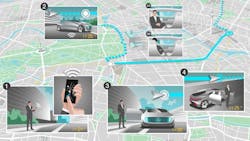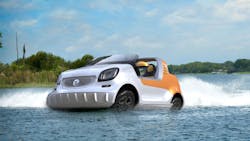Driverless driving in three years: Now that’s ambitious.
So component supplier Bosch and global vehicle maker Daimler AG recently announced they are joining forces to “advance the development of fully automated and driverless driving,” which really isn’t all that shocking, since almost every vehicle manufacturer – including heavy trucks OEMs – is engaged in similar research.
[Go here, here and here for just a few examples.]
Here’s the thing though: Bosch and Daimler said they plan to bring fully automated (SAE Level 4) and driverless (SAE Level 5) vehicles to urban roads by “the beginning of the next decade,” which is just a scant three years off.
As a reminder, the Society of Automotive Engineers (SAE) developed six distinct definitions of vehicle automation to help establish a firmer understanding of the technology.
Those six levels are:
- Level Zero – No Automation: The full-time performance by the human driver of all aspects of the dynamic driving task, even when enhanced by warning or intervention systems.
- Level 1 – Driver Assistance: The driving mode-specific execution by a driver assistance system of either steering or acceleration/deceleration using information about the driving environment and with the expectation that the human driver performs all remaining aspects of the dynamic driving task.
- Level 2 – Partial Automation: The driving mode-specific execution by one or more driver assistance systems of both steering and acceleration/deceleration by using information about the driving environment and with the expectation that the human driver performs all remaining aspects of the dynamic driving task.
- Level 3 – Conditional Automation: The driving mode-specific performance by an Automated Driving System of all aspects of the dynamic driving task with the expectation that the human driver will respond appropriately to a request to intervene.
- Level 4 – High Automation: The driving mode-specific performance by an Automated Driving System of all aspects of the dynamic driving task, even if a human driver does not respond appropriately to a request to intervene.
- Level 5 – Full Automation: The full-time performance by an automated driving system of all aspects of the dynamic driving task under all roadway and environmental conditions that can be managed by a human driver.
Bosch and Daimler, then, are aiming for the “end game” where self-driving is concerned – vehicles that can operate themselves without a human at the wheel.
“The objective is to develop software and algorithms for an autonomous driving system,” the companies noted in a joint statement; mirroring the phrase mentioned in SAE’s Level 5 description.
By introducing fully automated and driverless driving to the urban environment, Bosch and Daimler said they aim to improve the flow of traffic in cities, enhance safety on the road, and provide an important building block for the way traffic will work in the future.
“The technology will, among other things, boost the attraction of car sharing [and] will allow people to make the best possible use of their time in the vehicle and open up new mobility opportunities for people without a driver's license, for example,” they explained.
“The prime objective of the project is to achieve the production-ready development of a driving system which will allow cars to drive fully autonomously in the city,” Bosch and Daimler noted.
“The idea behind it is that the vehicle should come to the driver rather than the other way round,” they explained. “Within a specified area of town, customers will be able to order an automated shared car via their smartphone. The vehicle will then make its way autonomously to the user and the onward journey can commence.”
This is ambitious stuff, largely because many still feel the general public remains unready for fully autonomous vehicles to go whizzing along our streets.
But since we’re on this topic, let me add another wrinkle: what if such autonomy could be added to vehicles capable of operating on both land and sea?
That thought comes devolves from a new concept vehicle Daimler’s smart division is working on: the amphibious forsea, which seats two and is “inspired” by what the OEM calls the “classic lobster boat.”
[FYI: in an interesting development earlier this year, Daimler is no longer selling gasoline-powered “smart cars” in the U.S. and Canada, focusing instead on only electrified versions instead.]
It’s set to launch in Italy this summer, traversing the Strait of Sicily on its maiden test voyage.
Daimler noted that the wheels on the forsea are angled at 35 degrees, thus lining up with the hull and the underbody of the car. It can cruise the water at a speed of 10 knots, with peaks at 15 knots, along with – get this now -- three hours of “navigating autonomy.”
The forsea’s 90 hp rear engine is paired with a custom-made water-jet propeller and connected to a joint shaft on the rear differential, while transferring traction from the rear wheels to the water jet is managed by an ECU that handles the differential lock and transfers torque from the axles to the universal joint shaft.
So imagine this: an autonomous car that can pilot itself on asphalt and on water, perhaps even deciding on its own whether to go by land or by sea (in a coastal community of course) depending on traffic volumes.
That will be the day.


